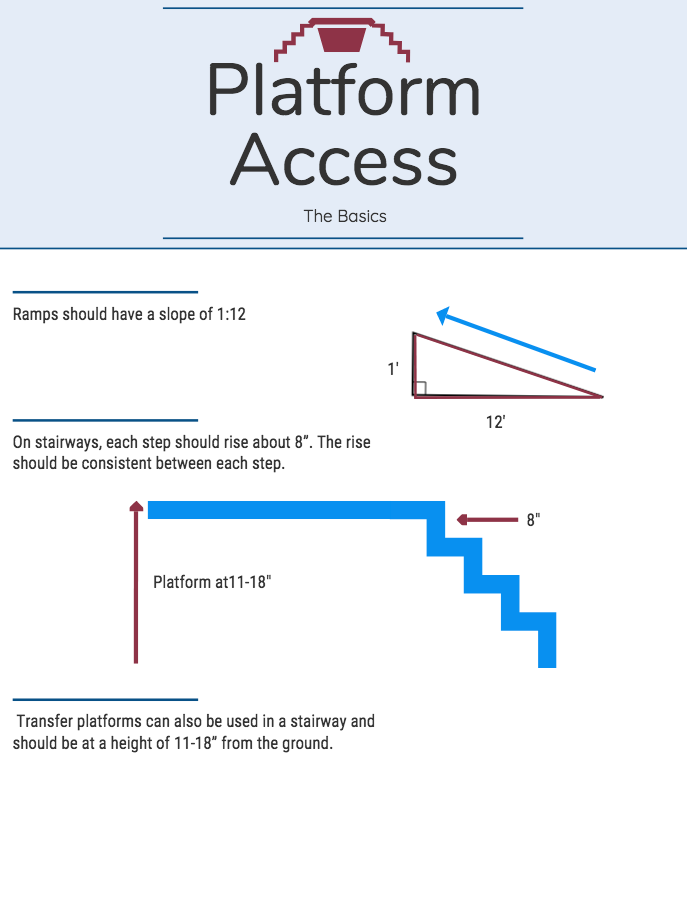There are many ways to access the elevated platforms of a playground, each one offering a unique challenge and new way to play for all age groups. There are, however safety concerns, especially younger children, that need to be taken into account.
Use Zone
Like with all other play structures, it is important that the ends of all ramps, stairs, and climbers are six feet away from any other equipment, borders, or other obstacles that children could fall into. Anything within six feet of the play structure can be dangerous to a playing child.

Ramps
Ramps are the easiest way for children to access an elevated platform, but it is especially easy for preschool-aged children. They are a great option because they are the most accessible to children with mobility concerns as well, especially for children with wheelchairs.
The slope of a ramp is an important part of its construction and can depend on the space available for the playground. The slope should not exceed a ratio of 1:12, or rising one foot for every 12 feet in length. The ramp should also have a landing if it is any longer than 12 feet with a diameter of at least five feet. The ramps should also be wide enough to accommodate all children, but the recommended width of a ramp is at least three feet. Following these regulations, guidelines help maintain the playground as a space that is truly as accessible as possible to every child.
Stairways
Stairways are a simple alternative to a ramp that are easy for young children to use. They have wide treads, handrails, and a low slope which makes them ideal for easy access to children with small feet and less balance.
In order to have a safe, easy to use stairway, each step should rise about 8”, and the rise should be consistent between each step. Transfer platforms can also be used in a stairway and should be at a height of 11-18” from the ground.
Stepladders
Stepladders are a form of access that pose a more interesting challenge to playing kids. They are more difficult to use, especially for preschool-aged children, who need more tread depth in order to easily climb. The use of a ladder can encourage them to develop balancing and motor function skills as they play.
The tread depth and riser dimensions can vary depending on age and it is important to remember that younger children with smaller feet and shorter legs will need smaller rising dimensions and larger treads to prevent injuries. Keeping the age group of a playground’s potential users in mind is key to building a fun space while still maximizing safety.
Handrails
Handrails are necessary for any stepladder or stairway and are important to consider when installing your playground. Besides the necessity of handrails, the specific design and dimension of the stepladder can vary greatly depending on your particular needs. They are especially important for the safety of children using more difficult means of access to the playground equipment. Starting at the very first step, at the leading edge, handrails provide support all the way to the end of the structure where it connects with a platform.
Handrails and handgrips need to be an appropriate size for children so that most of their hand is able to wrap around the perimeter. Both rigid and flexible components need to have a diameter of no more than 1.5”, and at least .6”. Flexible components, however, can be a little smaller in diameter, at least .6”. This will ensure that children of all ages can safely use the equipment.
Other Forms of Access
There are many other ways that an elevated platform can be accessed on a playground, and the more structures that are incorporated, the more interesting and challenging a playground will be children of all ages. Structures like arch climbers, flexible climbers, and ladders can be attached, but should not be attached to any structures over the platform itself to ensure that these more exacting elements do not become dangerous or hazardous themselves.
Arch Climbers
Arch climbers are certainly one of the more difficult pieces of equipment for a child to use on any playground. They are a fun challenge for many age groups but are difficult for younger kids to use. They should not, therefore, be the only way to access a platform, but used alongside ladders, stairs, or ramps, they will become a popular, more adventurous option for any playground.
Flexible Components
Any flexible components should also be accompanied by other means of access. They need to be properly anchored at both the top and bottom of the structure so that children are less likely to fall while climbing and needs to be anchored beneath the surface at the required depth. This is also an especially challenging element for preschool children, and so it is important that they have the ability to have both feet on the same level while climbing.
